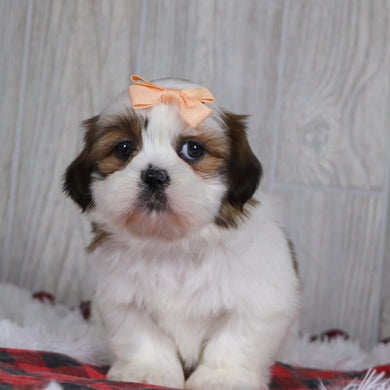
IMPERIAL SHIH TZU PUPPIES FOR SALE
Snuggly. Vivacious.
Also known as Chrysanthemum Dog or Lhasa Lion Dog, the Shih Tzu is ready to be your new furry best friend. Shih Tzu means “little lion” and is one of the oldest known breeds. Shih Tzus have been part of Chinese culture since the Tang dynasty when they were bred to be companions. These pups are friendly and vivacious and can easily get enough exercise even in small spaces. Because of the Shih Tzu’s double coat of long, flowing hair, this breed does require more grooming care than many other breeds. You won’t mind though, because Shih Tzus are great company for people and other animals.

Temperament
Shih Tzus are great alarms — they will let you know when strangers approach. (Be sure to properly manage barking with your young puppy to avoid problem barking.)
These dogs are usually relatively easy to train, but be ready to handle their stubborn streak. They are also known to be a challenge to housetrain.

Appearance
To keep hair from covering their large, expressive eyes, many Shih Tzu parents use a topknot. These pups have heavily furred ears and a heavily plumed tail that curves up over the back.
They are known for beautiful, long, flowing coats that come in:
- Black
- White
- Gray
- Brown
- Combinations of colors
They are typically 9 to 11 inches in height and 9 to 16 pounds in weight.

Exercise
We recommend 30 minutes of activity a day, walking about 6 miles a week.
However, Shih Tzus aren’t overly active and do well even in small living spaces.
Because of their small stature, Shih Tzu’s can be hurt easily. Keep a close eye on your pup’s interactions with other animals and small children.
The Shih Tzu breed is one of the oldest known and was favored by Chinese royals and kept at court as far back as the Tang dynasty, 618 to 907. Although we don’t know its exact ancestors, experts believe they are a cross between Tibet’s Lhasa Apso breed and a small Chinese dog like a Pekingese. Shih Tzus became popular with commoners in China during the Ming dynasty, but they almost disappeared during the Chinese Revolution. Somehow seven males and seven females were saved, and all of today’s Shih Tzus are descended from those 14 dogs.
These dogs began to appear in other countries and North America in the early 1900s. They were often referred to as Apsos. Clubs recognizing the differences between Shih Tzus and Apsos were not established until 1934 and 1935, but a standard defining the Shih Tzu’s unique characteristics wasn’t established until 1938. World War II veterans returning to the United States brought these vivacious little pups home with them from England. In 1969 Shih Tzus were recognized as a toy breed with the American Kennel Club. They became popular in the U.S. quickly and continue to be popular today.
Major health concerns to be aware of:
- Intervertebral Disc Disease
- Eye Problems
- Brachycephalic Syndrome
Minor health concerns to be aware of:
- Otitis Externa
- Urolithiasis
- Eye Disease
- Cleft Lip or Palate
The Shih Tzu’s distinctive coat is long and elegant, and it requires a great deal of upkeep. We recommend bathing weekly and brushing and combing daily. Doing so will keep them tangle- and mat-free, and it will also protect the underlying skin that can be damaged if mats are allowed to develop. This breed usually sheds less than others; however, when their mature coat replaces their juvenile coat at about two years old, they will temporarily shed more heavily.
Because the elegant show coat requires so much maintenance, many Shih Tzu parents opt to keep their coats short with grooming every 6 to 8 weeks. It’s helpful to get your puppy used to grooming early so they will become more cooperative with the process over time. Shih Tzus who have regular cuts will still require brushing and combing every two or three days, and you can wipe their faces with a damp cloth daily to keep their fur from staining.
These little pups can be sensitive to temperature, so be sure to protect them from excessive heat or cold. On very hot or cold days, indoor exercise may be the best choice. Finally, because of the Shih Tzu’s brachycephalic facial structure and small size, it’s susceptible to dental disease. Be sure to get dental care regularly.












